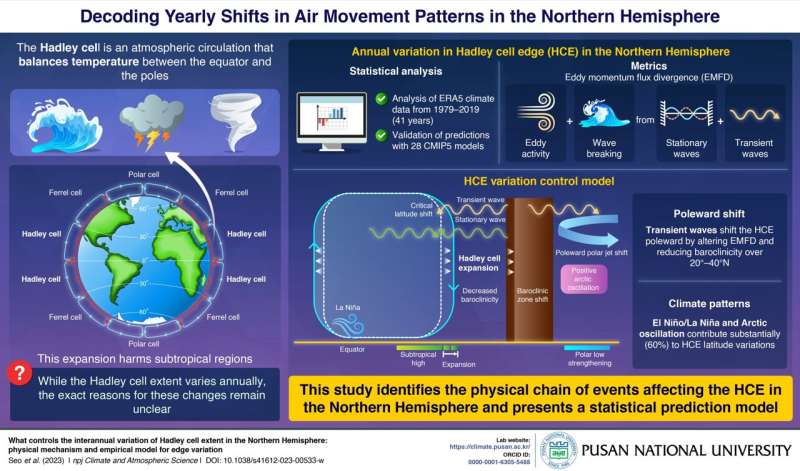This article has been reviewed according to Science X's editorial process and policies. Editors have highlighted the following attributes while ensuring the content's credibility:
fact-checked
peer-reviewed publication
trusted source
proofread
Researchers decode key airflow pattern impacting global climate

The Hadley circulation is a key atmospheric circulation pattern in the tropics. It helps even out the temperature between the equator and the poles by moving energy and momentum toward higher latitudes. However, recent studies indicate that the Hadley circulation cells have expanded toward the poles in the 21st century, increasing by several degrees each year. This expansion can have a substantial impact on the global weather and climate, resulting in adverse events like heat waves, droughts, and tropical cyclones
Although some studies have investigated the factors affecting the north-south variations of the Hadley cell, there is a lack of understanding about the dynamic mechanisms responsible for the year-to-year shifts.
Now, in a recent study published in the journal npj Climate and Atmospheric Science and led by Professor Kyong-Hwan Seo from Pusan National University, researchers have proposed a physical model that explains the shifts in the Northern Hemisphere Hadley cell edge latitude.
According to Prof. Seo, "During the expanded phase of the Hadley cell, many regions on the periphery of the subtropics experience unfavorable climatic conditions, such as prolonged drought spells and the more frequent occurrence of heat waves. In our study, the physical processes behind the interannual variation of the Hadley cell edge (HCE) latitude have been elucidated for the first time. Changes in subtropical and midlatitude eddy activity, not the change in jet location, control the HCE variation."
In this study, a total of 41 years of ERA5 climate reanalysis data (compiled by the European Centre for Medium-Range Weather Forecast) and sea surface temperature data were analyzed. The researchers discovered that the changes in the latitude of the Hadley cell were mainly caused by shifts in wind eddy activity and wave breaking from both "stationary" and "transient" waves. Furthermore, a substantial portion of the year-to-year variations was associated with El Niño, La Niña, and the Arctic oscillation.
These phenomena contribute to a poleward shift in the Hadley cell edge by inducing poleward movement of eddy activity. Moreover, the outcomes from 28 CMIP5 (Coupled Model Intercomparison Project Phase 5) simulation models were observed to match the observed variations in the Hadley cell, confirming the validity of the proposed mechanism.
The findings from this study are anticipated to be vital in addressing the significant impacts on the regional weather and climate worldwide resulting from the poleward expansion of the Hadley cell. This involves effects such as worsening aridity in the American Southwest, Mediterranean Europe, and southern China in the Northern Hemisphere, as well as reduced precipitation in southern Australia and southern Amazonia in the Southern Hemisphere.
"The rise in heat waves in central and western Europe could be linked to the Hadley cell's expansion during boreal summer. This expansion also shifts tropical cyclone tracks poleward, due to the poleward bulge of the subtropical high-pressure zone. Our study offers crucial insights into the physical events driving this expansion," says Prof. Seo.
Overall, this research is expected to have significant implications on our understanding of regional as well as global weather patterns.
More information: Kyong-Hwan Seo et al, What controls the interannual variation of Hadley cell extent in the Northern Hemisphere: physical mechanism and empirical model for edge variation, npj Climate and Atmospheric Science (2023). DOI: 10.1038/s41612-023-00533-w
Journal information: npj Climate and Atmospheric Science
Provided by Pusan National University




















